|
TennisOne Lessons
Completion PhaseJust prior to the forward swing, plant your back foot (the left foot for right-handers) and transfer your weight onto the front foot as straight-ahead as possible. Be sure to bend your knees (except for very high balls), but stay as erect as possible from the waist up. Dipping the lead shoulder is a common source of errors when hitting with underspin. Avoid hitting from an open stance. Ideally you want to step into the shot, but if you’re forced to step more across your body that’s usually ok. This is because you can still hit the slice well with a somewhat later contact point than on the other groundstrokes.
With this later contact point, you’re able to carry the ball longer because it allows for maximum extension of the arm into the shot. Hitting a slice backhand too early can actually result in a weak, “floaty” shot or a ball that lands in the net. There are those who advocate a severe “high to low” forward swing. This can definitely produce slice, but tends to cause the ball to float and lose pace. It may also give you the wrong idea about the finish. If you study the animations of Rafter or Philippoussis, you see that although the racquet moves downward after the hit, it still finishes high with the hand position close to the same height as a topspin drive. For these reasons, I prefer the racquet head start only slightly above where you’ll actually contact the ball. This makes for a simpler swing that allows you to generate plenty of spin, but still “drive” the ball.As you bring the racquet forward maintain a firm wrist. You arm should straighten out prior to contact, and stay that way all the way through the finish.
High speed video shows that at contact the racquet head will actually be square to the court. But trying to consciously create this position leads to real trouble. Don’t use the wrist to adjust the racquet face. Visualize the face as slightly open at contact and allow the forearm to roll through the shot naturally and make the adjustment. The racquet face will naturally reopen and stay that way to the finish. Aim
for the outside of the ball. The image of hitting across the ball
helps solidify ball contact. The follow through should be outward toward
the top of the net and upward toward the target. During the swing the player should strive to keep the shoulders sideways to the net position, and minimize the torso rotation. To ensure this, at the instant you begin the forward swing send the non-hitting arm in the opposite direction. Distance to the BallFinding the ideal distance between your body and the ball takes experience. If you’re too close, you’ll wind up leading the swing with your elbow, in which case the racquet face will be late and too open. If you’re too far away your arm will be overextended and you won’t be able to get any bite on the ball. For high-bouncing balls however, you do want to keep your body somewhat further away, and let your front leg straighten during the hit.
That covers the basic mechanics of generating slice, something you can apply to many situations, some of which we’ll be discussing in further lessons. No matter what style you play, it will make your game more flexible and well-rounded. Your comments are welcome. Let us know what you about think Scott Murphy's article by emailing us here at TennisONE.
|
Last Updated 4/1/01. To contact us, please email to: webmaster@tennisone.com TennisONE is a registered trademark of TennisONE and SportsWeb ONE; Copyright 1995. All rights reserved. |
||||||||||||||





